One of the most common defects at old Minneapolis and Saint Paul houses is a missing cleanout plug in the floor drain. When we find this during a Truth In Sale of Housing Evaluation in Minneapolis, it’s actually a required repair item. A missing cleanout plug can allow hazardous sewer gas into the home and often indicates a clogged floor drain. To learn why and how, read on.
Every plumbing fixture has a trap. A plumbing trap prevents foul-smelling sewer gas from entering a home. The image below shows a P-trap, which can be found at sinks, showers, and bathtubs.
The left side of the trap connects to the plumbing fixture, and the right side connects to the sewer. The ‘sewer’ side will have sewer gases present, but the water at the bottom of the trap prevents sewer gases from entering the building.
Floor drains are no exception. The photo below shows a floor drain viewed from the side.
The shaded portion shows the trap where water will always sit, which prevents sewer gas from entering the building. When you look at an installed floor drain, all that you typically see is the grill on top; the rest of the drain is always buried in the basement floor.
What if the drain is clogged?
Floor drains clogs happen in two places; one is the trap itself, and the other is a clog in the line downstream from the drain. To know the difference, try removing the cleanout plug; it’s that thing I circled in the photo below.
This will allow water to drain past the trap, through the area highlighted below.
If you remove this plug and water drains properly, you have a problem with the trap, and your best bet is to use a drain auger to clean out the trap. As long as someone didn’t pour concrete or tile grout down the drain, it shouldn’t be a big deal to fix this. If you remove the cleanout plug and water still doesn’t drain, you have a problem with the drain line downstream from the trap. Try using a drain auger to clean out the line by pushing it through the cleanout hole.
When this plug is removed, however, sewer gas will enter the building. After you’ve cleaned the drain, be sure to put the cleanout plug back into place. You don’t want stinky sewer gas coming into your home.
What if the cleanout plug is missing?
If you have an existing floor drain with a missing cleanout plug, it usually means one of two things:
- The drain was clogged, someone removed the cleanout plug to clean the drain, and they forgot to replace the plug.
- The bottom of the trap is clogged, and someone removed the cleanout plug to allow water to drain directly into the sewer, instead of going through the trap.
To know the difference, take a look at the water level. If the water is right at the cleanout hole, you have a clogged trap that needs service. If the water level is a couple of inches below the cleanout hole, you should be fine. All you need to do is replace the cleanout plug.
On some older floor drains, the threads that used to accept a cleanout plug are damaged or badly rusted, so it’s impossible to screw in a new cleanout plug. The right way to fix this is to install a rubber plug. One type of plug is a piece of rubber sandwiched between two pieces of metal that expand the rubber when tightened together. The two photos below show a rubber plug before it’s tightened and after it’s tightened.
Another type of rubber plug can be found at Real-Tite Plugs – a company located in Golden Valley.
When the cleanout plug is missing it needs to be replaced, and the floor drain may need to be cleaned out or replaced. If the drain cannot be cleaned, the entire floor drain needs to be replaced.


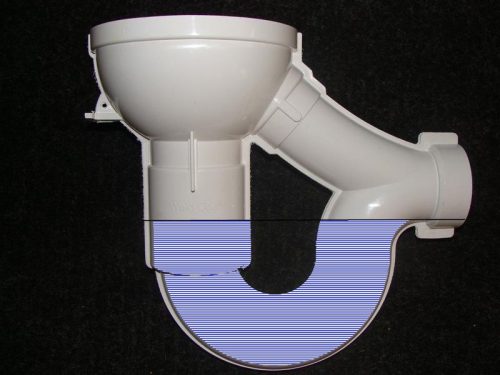
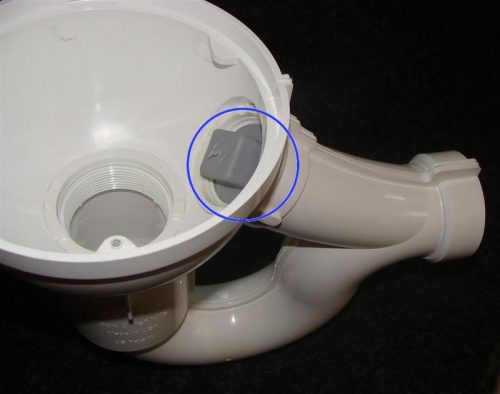
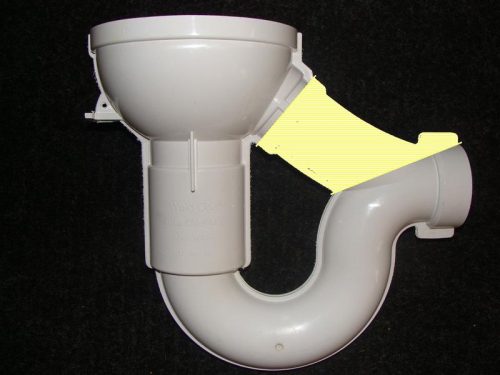
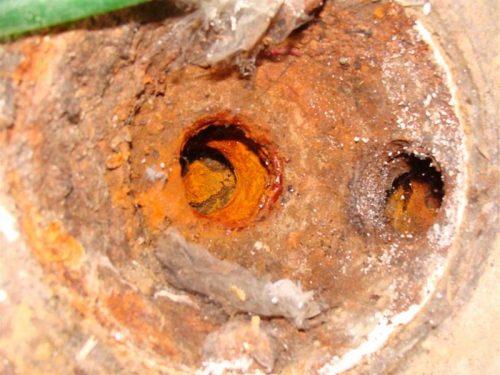
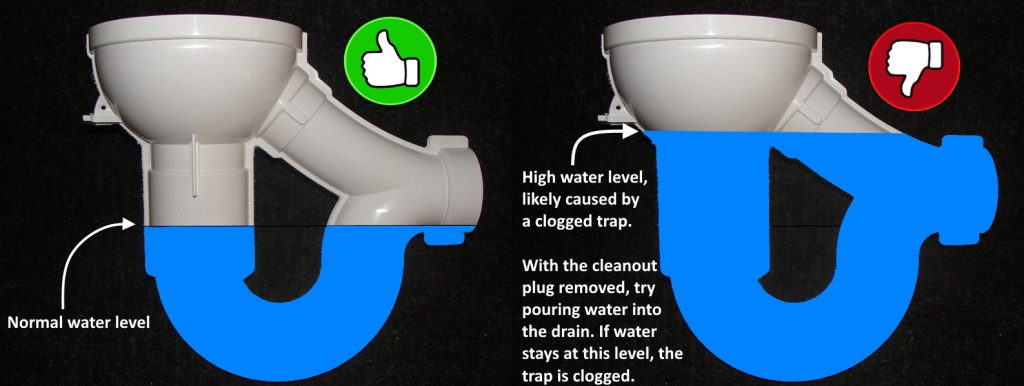
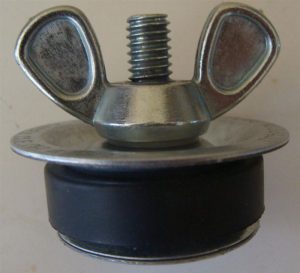
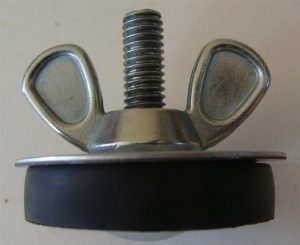
Susan
July 17, 2013, 5:17 pm
Hi. Can you tell me–I have a condensate pipe that feeds into a drain in my concrete basement floor. There is sump pump, as the basement is below ground. Is the condensate/floor drain leading into the sump pump pit? Cannot see anything since its under the concrete and there are walls, etc and the sump pump is difficult to get to. It is very hot and my ac is making a lot of condensate but the drain is very slow and I don’t see the sump pump doing anything. I’m guessing its clogged before it gets to the sump pump. Does this make sense? Should I snake it? I can’t see where the drain in the basement floor goes. What is the best approach?
Reuben Saltzman
July 17, 2013, 5:23 pm
The basement floor drain should drain to the sanitary sewer. If the drain is not functioning properly, try cleaning out the trap first. If that doesn’t help, try snaking it. Better yet though would be to hire a plumber to get to the bottom of it.
Carol Reingold
July 24, 2013, 12:11 pm
Hi- I was wondering if anyone knew what our house, from 1888, has in our basement- there’s an old plug, cement, about 2.5 feet in diameter. A handyman told me that it was some kind of older drainage system that they don’t make anymore, kind of like a stream underneath. I was wondering what it might be called and how it works. Our house never has leaked during any storm. We get condensation if we don’t run the humidifier, but never if we do.
Reuben Saltzman
July 26, 2013, 3:39 am
Carol – it might be a cistern. I’ve found a number of them under old houses in Minneapolis and Saint Paul.
Jim
August 7, 2013, 10:06 am
Hi – Informative site with interesting discussions.
My situation:
I live in Eden Prairie, MN in a house that was built in 1976. We have a floor drain in the laundry room of our basement. The furnace, water heater, and humidifier all run through this drain in the floor. Recently the drain has been backing up slightly on the basement floor when we wash clothes. (washer has a drain tub) The water subsides rather quickly. There is no smell from the floor drain. I snaked the cleanout hole to no avail.
My next thought was to snake the center hole to get at the p-trap. Interestingly the center hole of the floor drain always has a water level in it but the center hole is obstructed/sealed about 3 inches down. It appears to be some sort of buildup of material or calcification. I assume this is not normal. Any suggestions for next steps?
Thanks
Jim
August 7, 2013, 10:49 am
I forgot to mention in my previous post that the water that creates the backup on the basement floor through the floor drain comes through the cleanout hole.
Thx
Reuben Saltzman
August 7, 2013, 10:53 am
Hi Jim, just to be clear on this issue, how do you know the floor drain is “obstructed/sealed about 3 inches down” ? Have you tried pouring a bucket of water in to the drain? I’m thinking the obstruction you’re feeling three inches down is just the bottom of the trap.
Jim
August 7, 2013, 12:02 pm
Reuben,
When I suck up the water from the center hole (with a turkey baster, ha) I can get a view of the obstruction. It’s before the p-trap would begin to curve. So I really don’t think it’s the bottom of the trap. BTW it’s about 5 inches straight down not 3 as I indicated earlier. Hard to describe the obstruction. On top at least it is granular and or flaky. When I pour water down the center hole, it just spills over and drains through the cleanout hole.
I was hesitant to try and break through the obstruction with a snake until I confirmed somehow that it shouldn’t be there. What do you think? Also, if is determined that indeed what I have is an obstruction that shouldn’t be there, maybe using a snake isn’t the best way to go about it?
Reuben Saltzman
August 7, 2013, 3:30 pm
Jim – gotcha. It sounds like that obstruction shouldn’t be there, but at the same time, this also probably isn’t the cause of the floor drain backing up; it’s probably a problem with the drain downstream from both the floor drain and the laundry sink. Try snaking out the drain from the laundry sink instead.
Jim
August 8, 2013, 8:46 am
I agree —- it shouldn’t be the cause of the backup.
James
August 15, 2013, 10:03 pm
Im sorry if this may have been answered already. I researched many of the listings hoping to find an answer.
We live in Alberta, Canada our home was built in 1980. We have had a terrible odor problem for some years. The drains were scoped for breakage and they are fine.
The odor seams to immenate from the floor drain. The drain is a 5 inch hole with another pipe leading to it about 4 inches under level from the washer. The water in the drain smells horrible. Tonight I stuck my hands in and cleaned out alot of debris. For the sake of the comment lets call it debris cause it makes me feel better having handled 1.5 cups of it. I have never seen the drain dry so it still operates as a gas trap but the water and the debris smells horrible. When I pour hot water in it disperses out.
I am also confused because there does not feel like there is a P trap. It bends out at 45 degree about 6-8 inches underground and appears to head straight to the sewer.
1. What is the heavy sandy smelly debris?
2. What can I do to stop the smell?
Thanks you.
Reuben Saltzman
August 16, 2013, 3:42 am
Hi James,
My best guess is that this isn’t a floor drain at all, but a sewer cleanout hole that should normally be capped off. Some houses had traps for the entire plumbing system just before the drain left the house. If you run water from the other levels in the home, can you see water movement at this ‘floor drain’?
I don’t know what the debris is, but my best guess on stopping the smell is to cap the hole off.
Victor
August 16, 2013, 5:27 am
My floor drain has a bad odor. I pay Home Insurance. Can I claim or ask the Insurance to take care because this created bacteria inside my house ?
Thank you Reuben,
Victor
Reuben Saltzman
August 16, 2013, 8:50 pm
@Victor – I’m no expert on insurance, but I highly doubt it.
James
August 16, 2013, 6:31 am
Wow, you keep some awesome hours.
Aside from the pipe form the clothes washer that connects to the inside of the drain underground, no other pipes cross this opening. So water from other sources does not cross this opening.
The floor around this drain is sloped and it is located right by the hot water tank and laundry facilities.
It is strange that it is not a standard drain (P trap)
I will do more research. Thanks.
James
Daniel
August 24, 2013, 11:55 am
Hi Reuben, any tricks to getting the plug out? House was built in 76. Plug seems to be synthetic (plastic/rubber amalgam) my efforts with adjustable crescent wrench are wearing away corners of plug–concerned I’m gonna strip away any hopes of getting plug out. Thanks for excellent service to the community!
Reuben Saltzman
August 25, 2013, 12:09 pm
@Daniel – try destroying the plug by using a large screw extractor.
Daniel
August 25, 2013, 1:04 pm
On a related note, is it normal to have a ball/float inside the drain? The diagrams I’ve seen online have been accurate to my situation, including yours, but none have included a float that I assume helps keep gas from escaping?
Reuben Saltzman
August 26, 2013, 3:32 am
Yes, it’s normal to have a ball inside newer drains. That ball will help to prevent the drain from backing up, at least when it’s new and makes a good seal. It will also help to prevent the water in the trap from evaporating.
Karen Kinser
August 29, 2013, 7:29 pm
Reuben – searched high and low for an answer to my drain issues in the basement. Thanks to your awesome advice, I now know I have a clogged P-trap and I can (thankfully) try shaking before calling in the professionals. Your site is much appreciated!
Karen Kinser
August 29, 2013, 7:30 pm
…that was ‘snaking’ not ’shaking’. Sorry!
Marjorie Newland
September 12, 2013, 3:15 pm
I would greatly appreciate your advice regarding a small basement bathroom that is adjacent to the laundry. The room is a 5ft by 5ft area that has a cramped toilet, sink & shower. I removed a small panel kit style shower which just drained into an 8 inch wide floor drain that looks original to the 1958 home that set about 2 1/2 inches down into the cement floor. There is another drain under the washer in the laundry.What would be the most expedient solution to get the space to code? Should I (1) simply remove the shower fixtures and make this into a powder room w/ a small sink and toilet or ( 2) remove the sink (use the sink that is in the immediate laundry space) , move the toilet over so that it is spaced to code , and cover the walls w/ water proof panels and keep the shower fixtures,and tile the whole 5ft x 5ft area with porcelain tile? There are 2 other tub bathrooms in the home and another with a roll in shower.So another shower isn’t needed.Your insight would be super.Thanks in advance
Reuben Saltzman
September 12, 2013, 3:44 pm
@Marjorie – I would get rid of the shower.
Sam C
September 18, 2013, 10:26 am
Hi Reuben, I’m in central Texas and looking to lease a retail space that was formerly a salon. I’m turning it into a retail space and only need 1/4 of the drains in this place. Most of the plumbing work is strait forward to me but there are 2 big floor drains that were used at a pedicure station. They use 3″ pipe and do have traps, but they go down probably 4′ before the trap. These will not be used at all for my business and I’d like to concrete and lay flooring over them. What’s the best way to cap these? I’ve had a few suggestions just to toss a rag and/or tennis balls down there then fill with concrete. That seems like it would work but is that the ‘proper’ method? Could you see any future problems?
The previous tenant did complain about a sewage smell and insists all the traps were filled. There are 2 studer vents that seem to be okay and one vent out through the roof. Any other common culprits for the smell?
Thanks!
Reuben Saltzman
September 18, 2013, 1:39 pm
@Sam C – the rags and concrete sounds fine to me, but you should check with the municipal inspections department to see if they want a permit for the work; if so, they’ll tell you exactly how to plug the drains.
Sam C
September 18, 2013, 1:48 pm
Thanks for the original article and quick reply! Both have been very helpful.
Harry Cash
September 26, 2013, 6:48 am
I have a older slab home and some of the iron pipes are rusted through. How common would a floor drain with a rusted top area be that allows water under the slab? Thanks, Harry
Reuben Saltzman
September 26, 2013, 1:29 pm
@Harry C – I don’t think that situation would be typical.
Jim
October 2, 2013, 2:25 pm
Hi Reuben;
I originally posted this on August 7th of this year:
_________________________________________
My situation:
I live in Eden Prairie, MN in a house that was built in 1976. We have a floor drain in the laundry room of our basement. The furnace, water heater, and humidifier all run through this drain in the floor. Recently the drain has been backing up slightly on the basement floor when we wash clothes. (washer has a drain tub) The water subsides rather quickly. There is no smell from the floor drain. I snaked the cleanout hole to no avail.
— ——————————————————————–
What I neglected to mention in the above note that the original backup of water was at the drain tub not the floor drain. It got to the point where I had to bail the tub so it didn’t overflow. The first step I took was indeed to snake the drain from the tub to the limit of my 25 foot snake. Result was the drain tub now drained at a normal rate with no backup into the tub. But the water did back up at the floor drain. That’s when I posted my initial memo.
I then snaked the cleanout to the 25 foot snake limit. Water still backs up at the floor drain. Here’s what I am thinking: When I first snaked from the drain tub, I managed just to push the obstruction, whatever it was, further downstream down to the main line somewhere where it doesn’t backup to the tub anymore but not far enough to then stop the backup at the floor drain. I am guessing that maybe I need to do next is use a longer snake to see what happens. Your thoughts?
Reuben Saltzman
October 2, 2013, 2:27 pm
Hi Jim,
I think you’re right on with your guess. I’d rent a long snake and give it a shot.
Julie Cook
October 27, 2013, 6:18 pm
Hello Reuben – I found your site in June of this year while looking for info for what appears to be a drain in my basement – this a home built in the 1950’s in Rochester NY. We had a very wet spring this year and there was minor flooding in my basement to clean up – this is only the 2nd year I have lived here but understand that this basement has taken on water before. Though it seems the water came in surrounding the entire perimeter of the basement there was an area at what seems to be a drain where it persisted after most of the water had been pumped out or subsided. I don’t know what the drain is – and why water came in instead of out – at this source; The water was fresh water and no smell was involved. I would like to send you pictures but am not sure how on this thread. I have considered having a sump crock installed and am advised to pour concrete down this hole to seal it off. Would you advise doing that? And can you tell what the purpose of this hole was for if not originally a drain? Also, if you do have an opportunity to view my pictures, would the area where the drain now exists be a suitable location for the sump crock to be installed? I’m so glad to see recent dates on previous comments here and hope you will be so kind as to respond to mine. Thank you Reuben.
Reuben Saltzman
October 28, 2013, 3:38 am
@Julie C – you can email me at reuben@structuretech1.com . You would probably be better off taking advice from professionals that have already been to your home, however.
Julie B
October 27, 2013, 8:55 pm
Hi Reuben. I have scoured the web, and your site is the closest I’ve come to answering my problem. I’m hoping you have more insight, though. I have owned my 75 year-old home for 10 years, and annually in October the house takes on a foul, sewage gas-like odor. It comes from the basement. The floor drain does drain, and there is water in it, but it looks similar to the photos you show at the top of this page. The big difference is there does not appear to be the smaller hole to the side with the plug. It looks like the hole to the side does not exist. Why would that be and any guesses as to why this problem only exists in October?
Reuben Saltzman
October 28, 2013, 3:42 am
@Julie B – I don’t know why you would only have this issue in October. Try taping down plastic sheeting over the floor drain with duct tape. If the smell goes away, at least you’ve correctly identified the source.
Julie B
October 27, 2013, 9:36 pm
I should add the drain is highly rusted and flaky. I tried to clean it to find the side hole seen above and it just seemed to crumble. Should I suck out the water standing in the drain pipe with a shop vac and see if it’s clogged with the rust crumbs?
Reuben Saltzman
October 28, 2013, 3:42 am
@Julie B – and no, don’t start by sucking the water out.
Bill Thompson
November 3, 2013, 9:38 pm
Great article, glad you included pictures. We bought our house five years in Denver, CO. I didn’t notice that the basement floor drain was plugged, as in intentionally plugged with same type of screw as the clean out plug, and our inspector didn’t either or just didn’t tell us. It also has a clean out plug and the plug is in place. How should I proceed? Should I open it and see what happens? Or should I get a back flow adaptor, (I think that’s what it’s called.), or should I call a drain guy and have them scope it. Any insight will help.
Thanks, Bill Thompson
Reuben Saltzman
November 4, 2013, 4:38 am
@Bill – why not just leave it alone? Do you need a floor drain? If you do need a floor drain, open it up and try running water through it.
Wendy
November 11, 2013, 7:18 pm
Hi, I live in a home in East Central Mn in a home that was built in 1912. I have lived in my home for the past 5 years. The previous owner was a little old lady who washed her clothes in the kitchen sink and bathed once week. I have three kids plus myself so I use the plumbing a whole lot more than she did. In the past year our floor drain in the basement has become flooded about six times. It appeared to be clean water but I could see some remains of toilet paper. It eventually went down and then the problem would disappear for a month or so but the water always went away. Tonight I did a load of laundry and when I went to switch loads I had a very large amount of water on the floor. My daughter happened to be in the bathtub and when she pulled the plug not to my surprise I now have even more water. Unlike before the water is not moving. First off I am a single mother and have very limited income. What would you suggest I try to resolve this problem. I am afraid to even flush my toilet. I should add I live in city limits and have some very large trees between my house and the street. The trees are as old as the house. I am worried I have a huge problem on my hands.
Reuben Saltzman
November 12, 2013, 4:28 am
Hi Wendy, it sounds like your main drain line is clogged. The best advice would be to hire a drain cleaning service to clean out the drain, then perform a sewer scan with a fiber-optic camera to determine the condition of the drain. It know it sounds expensive, but you could probably get it done for under $200.
If that’s not in the budget, rent a large drain cleaning tool and snake the drain yourself.
Brandon
December 21, 2013, 11:46 am
Hi, Rueben I live in IL and I have a huge problem with my floor drain in my basement when I use my sink, dishwasher, and my washer they all run down the same two inch pipe till it hits the four inch pipe leaving basement. whenever those three things are going I get sewage water coming up out of floor drain.. I called a plumber out to snake it and all he did was make it flood more into my basement.. after that I called a different company and they don’t understand why its doing that. both my bathrooms and toilets work just fine you have any suggestions for me. I need help bad need my kitchen sink and washer machine back…thanks
Reuben Saltzman
December 22, 2013, 5:25 am
@Brandon – it sounds like you have a clogged drain. You need to get a different plumber out to fix it.
Cheryl Cantos
December 28, 2013, 11:05 am
Hi Reuben,
I hope you can help me. Last night I noticed a puddle in the middle of the basement floor. Nothing else around was wet, just the middle of the floor. There are no water pipes above or near the puddle. I searched for a source of the water but couldn’t find anything. This morning I watched water seep through the basement floor while my son was taking a shower in the upstairs bathroom. It seemed that once the water stopped draining from the bathroom, the water stopped seeping through the floor. Does this mean I have a leak in the drain pipe that runs under the house? That sounds like would be a huge problem. (I live on Long Island, NY. The house was built in 1956. We haven’t had a lot of rain lately.)
Reuben Saltzman
December 28, 2013, 8:37 pm
Hi Cheryl, yes, it definitely sounds like you have a leak in the drain that runs under the house.
Dan
January 5, 2014, 1:50 am
Dan from Minneapolis.At my parents house in Brooklyn Center built in late 50’s. I used the clean out of the basement shower drain and the partly cleaned out P trap as the drain and fit a bell trap into the top of the drain.It raised the new grate up a 1/4″ but by adding floor tile to the shower base and the cement block walls it was a nice remodel and retro fit. I did have to drill and insert anchors for the new and larger grate.Would like to know your thoughts on using a bell trap in new projects and to repair the old P trap. They are easier to snake out, trap attached to grate and small objects are easily retrieved.
Thanks Dan
I didn’t read all posts so you might have already..
Reuben Saltzman
January 5, 2014, 7:09 am
Hi Dan,
I don’t have much experience with bell traps, but I do know that they’re not legal. If you’re going to remodel, I recommend you break up the floor and install a new floor drain if there’s a problem with the old one. I know it’s more work, but I’ve always found it’s worth it to do it right the first time.
Reuben Saltzman
January 5, 2014, 7:09 am
Hi Dan,
I don’t have much experience with bell traps, but I do know that they’re not legal. If you’re going to remodel, I recommend you break up the floor and install a new floor drain if there’s a problem with the old one. I know it’s more work, but I’ve always found it’s worth it to do it right the first time.